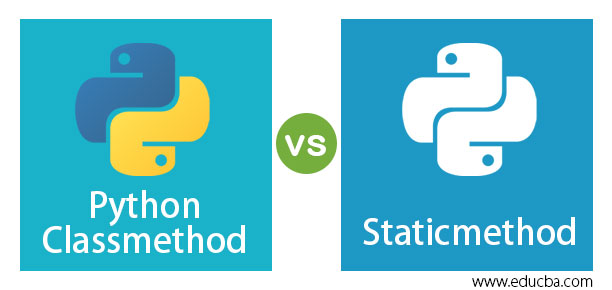Updated April 13, 2023

Difference Between Python Classmethod vs Staticmethod
In this article, we are going to learn about Python Classmethod vs Staticmethod with the given key differences and comparisons.
Preface
Instance Method, Class Method, and Static Method are OOP concepts in Python which are the built-in functions. The classmethod() and staticmethod() return a class method and static method for the given function respectively.
Instance Methods in Python differ with Class Method and Static Method as they are ordinary and can access distinct data of an instance. Unlike a static method, class method and instance method are obliged to have a self parameter.
In newer versions of Python, we must use @classmethod and @staticmethod decorators because the prior representation is considered senile and unpythonic.
Decorators
Before understating the dissimilarity of the above methods, It is important to understand about the decorator patterns, straightforwardly called Decorators.
Decorators can be written by the user or extract from the Python standard libraries (It is possible to combine multiple decorators), as they are simply functions and they perform tasks. They change the behavior of other functions or apply logic. Code reusability and logic separation are excellently performed.
Decorator patterns are prioritized for defining static() and class().
They start with the sign @.
Syntax
Here is the syntax mentioned below
1. Class Method
class new_class:
@classmethod
def name_of_function (cls, arguments):
#body of the function
return value
2. Static Method
class new_class:
@static method
def name_of_function (arguments):
#body of the function
return value
General Characterization
class Dear_class:
def method(self):
return 'This is instance method', self
@classmethod #Decorator used
def classmethod(cls):
return 'This is classmethod', cls
@staticmethod #Decorator used
def staticmethod():
return ' This is static method'
Parameters
Here are the parameters mention below
1. Class Method
This method hops to a class rather than its object. No necessity of creating a class instance. This is much similar to the static method.
The parameters of the Class method is predominantly the class itself and hence it associates with it.
Creating a Class Method:
class Xname:
year_of_birth = 1992
def printAge(cls):
print('The age is:',2020 - cls. year_of_birth)
# create printAge class method
Xname.printAge = classmethod(Xname.printAge)
Xname.printAge()
The output of the above code:
2. Static Method
These are much like Class Methods and they hop into a class rather than the object.
The Static Method is independent on the state of the object and hence Instance creation of a class is not required.
The static method deals with the parameters and hence does not interact with the class or at least have knowledge about it.
Creating a static Method:
class SimpleMath:
def addition(a, b):
return a + b
# creating a static method
SimpleMath.addition = staticmethod(SimpleMath.addition)
print('The result is:', SimpleMath.addition(5, 10))
The output of the above code:
Head to Head Comparison Between Python Classmethod vs Staticmethod (Infographics)
Below are the Top Comparison Between Python Classmethod and Staticmethod:
Key Differences
Learn the key differences between Python Classmethod and Staticmethod
Python Classmethod
|
Staticmethod
|
When you put a method in the class, you put a regular function there. When you call the same through the class instance, it magically inserts extra parameters. It is convenient if you are used to object-oriented programming because it behaves exactly like an object-oriented method does while it is using a normal function implementation.
The static method lets you define a function that does not have an implicit self argument. When you call it, it does not do the transform anymore.
d.static_method(1,2)
static_method (1,2) #directlyIt is a stand-alone method. It just happens to be inside a class. There is no parameter inserted at the start of it based on what it was called on.
An option for that is a class method.
It takes the first object and inserts the first parameter. Except in this, it is a little more clever. When we do this transformation on class method, we take the type of D. So this call turns into class method meaning,
d.cls_method(1,2)
cls_method (type(d),1,2)Comparison Table of Python Classmethod vs Staticmethod
Now let’s draft the comparison in a table below
| Class Method
1. Defined as Mutable via inheritance 2. The first parameter as cls is to be taken in the class method. 3. Accession or modification of class state is done in a class method. 4. The class keyword application is bound to creating a static method. 5. Class methods are bound to know about class and access it. 6. Class is the parameter of class methods. 7. Decorator used in the class method is: @classmethod |
Static Method
1. Defined as Immutable via inheritance 2. Parameters in specific are not needed in the static method. 3. Accession or modification of the class state is undone in the static method. 4. A static keyword application is bound to creating a static method. 5. Static methods no purely nothing about the class. 6. Working on parameters is done by taking utility type methods. 7. Decorator used in a static method is: @staticmethod |
Conclusion
Class methods are alternative to constructors and Static methods do not operate on instance or class in Python. In the real-world, examples such as creating an object are considered like date/time module and the passing in year/month and date you use the current time.
when you get into the actual function body, this parameter class is the type of the object it was called on. This can be handy if you are using inheritance.
Recommended Articles
We hope that this EDUCBA information on “Python Classmethod vs Staticmethod” was beneficial to you. You can view EDUCBA’s recommended articles for more information.



